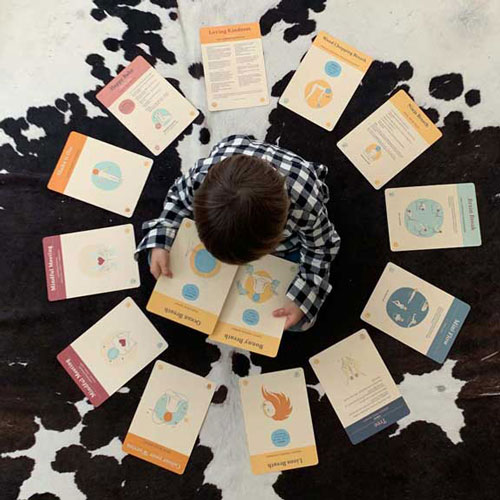5 ways to teach life-long mindfulness in our children

Mindfulness - or learning how to be in the present moment – teaches us how to see and accept things as they are, without emotion or judgment, to simply be in the moment with a sense of equanimity and calm. Mindfulness experiences force us to slow down and pay attention. In just a couple of minutes of mindfulness activity, we can shift from a hyper, stressed state to one that is more calm and more balanced.
Cultivating mindfulness teaches children how to be less reactive, more in touch with how they feel, compassionate and thoughtful. They become better skilled at managing stress and are better able to stay rational in both thought and behaviour.
Beth Borowsky, founder of The Karma Class, is an educator, yoga teacher and teacher trainer who believes that one of the most treasured gifts we can give children today is the experience of being quiet, in both body and mind. By offering short experiences of quiet time and relaxation – through visualisations, mindfulness exercises, silent moments, calming music - children begin to experience and reap the benefits of a mindfulness practice and the beauty of being quiet inside. They learn wonderful tools to draw from when they feel stressed, anxious or upset.
Here she suggests 5 ways to gift children with mindfulness activities and skills.
Yoga
Kids love to move. They love to explore with their bodies and yoga is a low-cost, non-competitive, healthy and fun option for helping children to feel good about themselves, both inside and out. The strengthening, lengthening, twisting, bending and stretching, coupled with smooth breaths, creates mental and physical focus and encourages children to feel more vibrant and less reactive while boosting self esteem.
Deep breathing
Teaching children about their magical breath is an invaluable gift. Focusing on the breath helps to alleviate stress, reduce anxiety and bring the body and mind into quiet balance. Our breath is the only system in our body that we can consciously control. This is why it’s magical! When we learn to cultivate conscious (and longer) inhale breaths, we increase the oxygen in our blood stream, which helps to alleviate tired muscles and brains. When we extend our exhales, we tap into our para-sympathetic nervous system (rest and digest) which instantly helps us to feel calmer.
Just a few minutes of deep belly breathing overrides the stress response halting the production of the flight-fight hormone cortisol. The relaxation response is triggered, helping children to feel more vibrant, less reactive, more balanced and focussed.
When your child stressed and you’d like them to calm down or relax, lie down comfortably with your hands on your belly and do some slow mindful belly breaths. Pretend to blow up a balloon and feel your belly rise into your hands as you inhale slowly and, as you exhale, feel it draw back to your spine.
Walking meditation
Walking meditations are a fun and easy way to cultivate mindfulness. Next time you’re in the park, take off your shoes and enjoy a mindful walk in silence. Play a game:
- what does it feel like to place each foot down really slowly and carefully;
- can they find only orange flowers;
- notice all the crawly bugs;
- what different smells can they smell
Visualisations – Imagination Vacations
Guided visualisations is one of the most common mindful techniques used to nurture self awareness and help children to better understand their feelings. It guides them on an imagination vacation to a happy place where they may be floating on a cloud, swimming at the bottom of the ocean alongside a friendly turtle, or deep inside the rain forest beside a wishing tree. This creative meditative technique mentally transports the child to an imaginary utopia where everything is peaceful and calm, and where they feel safe to connect to their inner wisdom and explore what may otherwise create distress or fear.
Children have great imaginations and so respond more easily to this very simple, yet highly effective technique. They’re guided through a story that is filled with delightful images, and are invited to see, hear, taste, touch and smell with their imagination and feel safe to whisper their worries to an imaginary friend or give a colour to their fears.
Colouring
Mindful colouring invites children to quietly focus on whatever it is they are colouring. Download mandalas – circular patterns to be coloured in – and invite your child to simply enjoy the art of colouring, without any judgement. It’s a great stress release, cultivating calm and focus. Play some quiet soothing music in the background.
Beth Borowsky holds a Masters in Early Childhood Education, is a kids and adults yoga teacher and teacher trainer. She is the founder of The Karma Class and her accredited workshop A Calmer Classroom teaches teachers how to easily weave Yoga, Breath and Mindfulness into every school day – inspired techniques that start in the classroom and last a lifetime.
